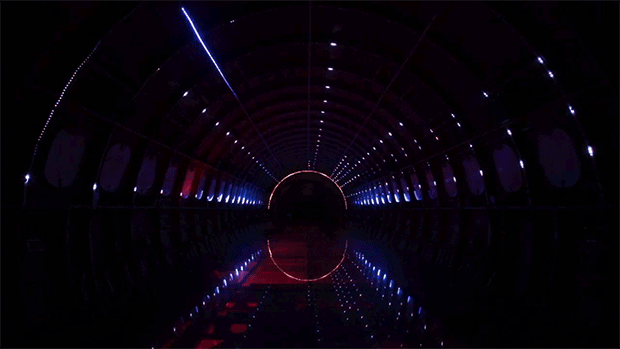Sophia is the managing editor of the Make: blog. When she’s not greasing editorial gears, she likes to run, ride, climb, and lift things, and make lo-tech goods like zines, desserts, and altered clothing. @sophiuhcamille
View more articles by Sophia Smith
How would you like to explore the galaxy? Travel to faraway stars and nebulas, and maybe even see some alien life forms… Just take a trip through Porta Estellar and you’ll be transported light years away and back in just six Earth-minutes. It’s housed inside of an old DC-9 airplane. And while it doesn’t leave the ground, some attendees said that this light show did actually make them feel that they had taken flight.
Porta Estellar, Catalan for “Star Gate,” is a completely immersive installation that uses light and sound to transport those who enter the salvaged airplane. The installation was designed and constructed by Eloi Maduell and Santi Vilanova of Playmodes, in collaboration with the owner of the plane, Eduardo Cajal.
Two hundred meters of RGB LED strips act as a “visual skin” that lines the inside of the hull. Paired with a smoke machine, a subwoofer, and eight speakers placed throughout the plane, the show aims to engage attendees on various sensory levels. The creators said they were strongly inspired by sci-fi movies like 2001, Contact, and Star Wars, and by the literature of Isaac Asimov, although Vilanova tells me he felt that the plane itself, in addition to being a vessel for long distance transport, was “kind of asking for an installation like this, because of its strong perspective lines.”
Vilanova explained how they brought this installation from conceptual to physical through 3D mapping:
We developed a 3D simulator of the plane in Unity3D, so that we could create the video contents and have an idea of what the final result was going to be. The 2D video contents were mapped pixel-by-pixel to the virtual 3D model, unfolding the image on the plane’s volumetry and giving a realistic approximation of the final installation.
We also had to engineer the hardware system, figuring out the optimal placement and amount of power sources, and preparing the LED strips with enough wiring to receive the control signals. On the control signal side we used the art-net protocol and a pixel-mapping software. The audio installation featured eight speakers with independent signals, creating all sorts of audio-perspective effects.
The team had to employ a variety of different software to bring the project to completion:
- Cinema4D: 3D modeling of the plane and UV mapping
- Unity3D: 3D simulator of the plane, which allowed the Makers to work on the show at home, without the need to set-up everything in advance
- Aftereffects: Visual contents creation
- Syphon: Used to send video textures in realtime from Aftereffects to Unity, so that pixels are mapped in the 3D space of the simulator
- Reaktor: Audio synthesis engines
- Cockos Reaper: Multichannel audio edition
- Madmapper: pixel mapping and show triggering
- MaxMSP: multichannel audio and OSC triggering

The plane, it turns out, is an art piece of its own. It was salvaged after it crashed at the Granada airport in 1992, and then purchased and restored by Cajal. Cajal, a sculptor, has since collaborated with many artists who have used the plane to house their various installations over the past 10 years. Cajal’s overarching project operates under the name “Trashumante,” or “Migratory,” an allusion to the cultural migration of projects and artists, and of the metamorphosis of the plane itself. Cajal is also interested in memory, and how the plane’s black box “remembers” what has taken place inside. He says that the entire project has become a container for contemporary memory, generated by the journeys and actions that are documented by the black box.
Experience the journey for yourself through the below video, which documents the installation’s stint in Barcelona’s Ciutadella park during Barcelona’s La Mercè festival of this year.
Porta Estel·lar from Playmodes on Vimeo.
Sophia is the managing editor of the Make: blog. When she’s not greasing editorial gears, she likes to run, ride, climb, and lift things, and make lo-tech goods like zines, desserts, and altered clothing. @sophiuhcamille
View more articles by Sophia SmithADVERTISEMENT






